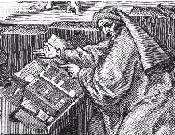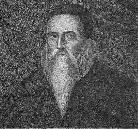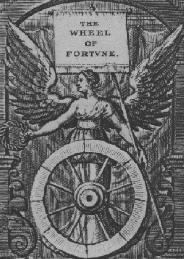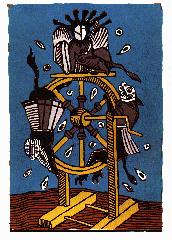Alchemy,
Witchcraft, and the Magus Figure in The Tempest

Detail from An
Alchemist at Work (mid 16th cent) by Pieter Breughel the
Elder (1525-1569).

John Dee
(Alchemist who appealed unsuccessfully to James I in 1604 to be
cleared of charges of conjuring Devils)

James I
(Author-as James VI of Scotland-of Daemonology, in forme of a
Dialogue)
The figure of the Magus, a combination
of Alchemist and Magician, is quite current at the time of the
first performance of The Tempest. In fact, Ben Jonson's The
Alchemist is being played at the same time, and by the same
theater company as is The Tempest. Prospero can be seen
as following in the tradition of such real-life figures as
Paracelsus, John Dee, Jacob Boehme, as well as the legendary
Faust. Paracelsus (1493-1541), the great reformer of alchemy,
also wrote on religious and spiritual matters, and his influence
on late 16th and early 17th century alchemy was profound.
Alchemy was often associated with wizardry and witchcraft. The
alchemist John Dee (1527-1608) was accused of conjuring Devils,
and unsuccessfully appealed to the demon- and
witchcraft-obsessed James I to be cleared of these charges.
During the early 17th century Jacob Boehme (1575-1624) wrote a
number of mystical works, some of which drew on Paracelsist
alchemical ideas - the Signaturum Rerum, the Threefold
life of Man, and the Four Complexions. These were
published throughout the 17th century and developed a new thread
of mysticism, with alchemical resonances.
What is
alchemy?
"Alchemy is of a twofold
nature, an outward or exoteric and a hidden or esoteric.
Exoteric alchemy is concerned with attempts to prepare a
substance, the philosopher's stone, or simply the Stone, endowed
with the power of transmuting the base metals lead, tin, copper,
iron, and mercury into the precious metals gold and silver. The
Stone was also sometimes known as the Elixer or Tincture, and
was credited not only with the power of transmutation but with
that of prolonging human life indefinitely. The belief that it
could be obtained only by divine grace and favor led to the
development of esoteric or mystical alchemy, and this gradually
developed into a devotional system where the mundane
transmutation of metals became merely symbolic of the
transformation of sinful man into a perfect being through prayer
and submission to the will of God. The two kinds of alchemy were
often inextricably mixed; however, in some of the mystical
treatises it is clear that the authors are not concerned with
material substances but are employing the language of exoteric
alchemy for the sole purpose of expressing theological,
philosopical, or mystical beliefs and aspirations" (E. J.
Holmyard, Alchemy, London: Penguin, 1957, 15,16).
What about
Magicians and Witches?
The existence of magicians and witches
is taken very seriously in the period stretching from the 15th
through the 17th centuries. The following selection
from a Papal Bull of 1484 serves as an example:
Innocent VIII: BULL Summis
desiderantes, Dec. 5th, 1484
Bullarium Romanum (Taurinensis
editio), sub, anno 1484.
Innocent, bishop, servant of
the servants of God, Ad futuram rei memoriam
It has recently come to our
ears, not without great pain to us, that in some parts of upper
Germany, as well as in the provinces, cities, territories,
regions, and dioceses of Mainz, Ko1n, Trier, Salzburg, and
Bremen, many persons of both sexes, heedless of their own
salvation and forsaking the catholic faith, give themselves over
to devils male and female, and by their incantations, charms,
and conjurings, and by other abominable superstitions and
sortileges, offences, crimes, and misdeeds, ruin and cause to
perish the offspring of women, the foal of animals, the products
of the earth, the grapes of vines, and the fruits of trees, as
well as men and women, cattle and flocks and herds and animals
of every kind, vineyards also and orchards, meadows, pastures,
harvests, grains and other fruits of the earth; that they
afflict and torture with dire pains and anguish, both internal
and external, these men, women, cattle, flocks, herds, and
animals, and hinder men from begetting and women from
conceiving, and prevent all consummation of marriage; that,
moreover, they deny with sacrilegious lips the faith they .
received in holy baptism; and that, at the instigation of the
enemy of mankind, they do not fear to commit and perpetrate many
other abominable offences and crimes, at the risk of their own
souls, to the insult of the divine majesty and to the pernicious
example and scandal of multitudes (emphasis added).
A popular Witch-hunting manual of the
late 15th century also serves as background for
beliefs still-current in the time of James I:
Extract from THE HAMMER OF WITCHES
[Malleus maleficarum], 1486
The method of beginning an
examination by torture is as follows: First, the jailers prepare
the implements of torture, then they strip the prisoner (if it
be a woman, she has already been stripped by other women,
upright and of good report). This stripping is lest some means
of witchcraft may have been sewed into the clothing-such as
often, taught by the Devil, they prepare from the bodies of
unbaptized infants, [murdered] that they may forfeit salvation.
And when the implements of torture have been prepared, the
judge, both in person and through other good men zealous in the
faith, tries to persuade the prisoner to confess the truth
freely; but, if he will not confess, he bid attendants make the
prisoner fast to the strappado or some other implement of
torture. The attendants obey forthwith, yet with feigned
agitation. Then, at the prayer of some of those present, the
prisoner is loosed again and is taken aside and once more
persuaded to confess, being led to believe that he will in that
case not be put to death.
The character we know as
Faust-or Faustus-apparently has at least a root or two in an
historical figure who lived from approximately 1480 to 1540. A
letter written by Johannes Tritheim (a physicist and writer who
lived 1462-1516) refers to a "Master George Sabellicus, the
younger Faust, the chief of necromancers, astrologer, the second
magus, palmist, diviner with earth and fire, second in the art
of divination with water"(Eric Bockstael, Lives of
Doctor Faust, Detroit, Wayne State UP, 1976, 37). Faust is
mentioned twice in the Tischreden, the records of the
conversations of Martin Luther with his friends, family, and
acquaintances:
When one evening at the table
a sorcerer named Faust was mentioned, Doctor Martin said in a
serious tone: "The devil does not make use of the services
of sorcerers against me . . . . Mention was made of magicians
and the magic art, and how Satan blinded men. Much was said
about Faust, who called the devil his brother-in-law, and the
remark was made: "If I, Martin Luther, had given him even a
hand, he would have destroyed me; but I would not have been
afraid of him-with God as my protector, I would have given him
my hand in the name of the Lord" (Bockstael 40,41).
In the English Faustbook of
1592, The Historie of the Damnable Life, and Deserued Death
of Doctor Iohn Faustus, itself a translation of the German Spiess
Faustbuch of 1587, Faust's story is presented as a warning
to European Christians who might feel the temptation to
transgress metaphysical boundaries of experience and knowledge
"proper" to servants of Christ. The "Master
George Sabellicus, the younger Faust" has become Doctor
John Faustus, a legendary figure consumed by an hubristic desire
to know more than he is permitted to know by his limited human
perceptions, who "taking to him the wings of an Eagle,
thought to fly over the whole world, and to know the secrets of
heaven and earth" (Bockstael 65,66). Faustus sells his soul
to the Devil, writing, and signing the contract in his own
blood: "Now have I Doctor John Faustus, unto the hellish
prince of Orient and his messenger Mephostophiles, given both
body and soul" (Bockstael 74). After twenty-four years of
having demonic power at his command-during which time he is
given a tour of Hell, lives off the riches of kings, emperors,
and the Pope, and raises the famous Helen to be his lover-he
meets his end: "the Devil had beaten him from one wall
against another, in one corner lay his eyes, in another his
teeth . . . his body [was] lying on the horse dung, most
monstrously torn, and fearful to behold, for his head and all
his joints were dashed in pieces" (Bockstael 205).
King James I of England took
the ideas of alchemy, wizardry, and magic seriously enough to
write (in 1597, as James VI of Scotland) a book entitled Daemonology,
in forme of a Dialogue. "For James the devil was very
real, the incarnation of evil and witches, mostly old hags, were
his instruments. James' hatred of the devil was fanatical . . .
. James . . . [attacked] those who publicly denied witchcraft,
such as an Englishman called Reginald Scott, a hop-grower from
Kent, and a German physician called Vvierus" (Bryan Bevan, King
James VI of Scotland & I of England, London, Rubicon,
1996, 47). James held it blasphemy not to believe in the
ability of witches and magicians to bring "Wine out of a
Wall," to raise storms, and to commune with spirits.
Well, that's
all very interesting, but what the hell does any of that have to
do with The Tempest?

Still shot
of John Gielgud as Prospero
- Prospero's fascination with his
books, his being "rapt in secret studies"
(I.ii.77), is what leads to his initial downfall. Prospero
neglects "all worldly ends, all dedicated / To
closeness and the bettering of [his] mind"
(I.ii.89,90), thus opening the door for his usurping brother
Antonio.
- It is Prospero's art ("Lie
there, my art" [I.ii.25] he says as he removes his
mantle in order to converse with Miranda) that enables him
to "Put the wild waters in this roar" that Miranda
begs him to allay (I.ii.1,2). The control of the elements
was one of the primary goals of "exoteric"
alchemy, and it was reputed to be among the abilities of
magicians and witches.
- It is his art that allows Prospero
to release Ariel from the spell of Sycorax, the twelve-year
confinement "Into a cloven pine" (I.ii.277).
Ok, I can see
Prospero as a magician, but how does he fit into the role of
alchemist?
Both the exoteric and esoteric
traditions within alchemy were concerned with transformation.
Transformation, especially through "mystical" or
"magical" experiences, is a constant theme in The
Tempest.
- Alonso, the King of Naples and the
father of Ferdinand (the eventual husband of Miranda),
suffers a "sea-change" in Ariel's famous song of
I.ii.397-405. "Of his bones are coral made: / Those are
pearls that were his eyes: / Nothing of him that doth fade,
But doth suffer a sea-change / Into something rich and
strange." This transformation, this sea-change, is
brought about through Prospero's art. His magic thus serves
the ends of esoteric alchemy, the mystical spiritual
tradition concerned with the transformation and refinement
of the individual into a more perfect being.
- The theme of the sea-change runs
throughout the play. Prospero himself suffers this
sea-change as he journeys from being the newly-usurped Duke
of Milan who "deck'd the sea with drops full salt"
(I.ii.155) to being the wise and wizened magus who puts
"the wild waters in [the] roar" that brings the
ship to his island, then finally to being the man who
forgives his wrongers in V.i.
- Caliban suffers a variety of
sea-change as he comes to the realization that Stephano and
Trinculo are merely drunken sots, not gods as he asked
Trinculo to be at II.ii149. As Caliban wades through the
pool that smells "all horse-piss" (IV.i.199), he
sees Trinculo and Stephano for the drunken fools they are:
"The dropsy drown this fool! What do you mean / To dote
thus on such luggage?" (V.i.230,231) asks Caliban of
Trinculo and Stephano as they argue over the possession of a
gown instead of following through on the previously-plotted
murder of Prospero. Caliban's own last lines reveal a
transformation into a character more aware than before of
his tendency toward self-abasement: "What a
thrice-double ass / Was I to take this drunkard for a god,
And worship this dull fool!" (V.i.296-298).
- Alchemical symbolism may be seen in
the portrayals of Prospero's two primary servants, Ariel and
Caliban. Ariel is fire in I.ii.195-205, reporting his
activities to Prospero in this manner: "I boarded the
King's ship; now on the beak, / Now in the waist, the deck,
in every cabin, / I flam'd amazement." Caliban, on the
other hand, is referred to as "Thou earth"
(I.ii.314). These are two of the opposites alchemy was
concerned to unite. Fire, is a symbol of the ethereal, the
"soul" or spirit, while earth is a symbol of the
physical, the fleshly, the material. These are the opposites
that Prospero struggles with in his journey from the desire
for revenge to the granting of forgiveness. At the end,
Prospero grants Ariel (fire, spirit) his freedom, and
acknowledges Caliban (earth, materiality, flesh) as his own:
"this thing of darkness I / Acknowledge mine"
(V.i.275,276).
Another interesting theme that operates
in The Tempest is that of the wheel of Fortuna,
symbolized in cycles of twelve: twelve years of imprisonment for
Ariel in "a cloven pine" (I.ii.277); twelve years of
imprisonment for Prospero on the island; the twelve phases of
the zodiac. This all comes together in I.ii.178-184: "By
accident most strange, bountiful Fortune / (Now my dear lady)
hath mine enemies / Brought to this shore; and by my presience /
I find my zenith doth depend upon / A most auspicious star,
whose influence / If now I court not, but omit, my fortunes /
Will ever after droop."
Fortuna's
Wheel

The wheel of Fortune was a legacy to
the Middle Ages from the second book of Boethius' Consolation
of Philosophy. It took on many styles, from the delicately
drawn miniatures of fine manuscripts to the huge rose windows of
the cathedrals at Amiens and Basel. Fortuna herself is often
drawn larger than the human figures, in accordance with medieval
convention, to underscore her greater importance. The wheel is
frequently absurd in its mechanics: Fortuna may propel it with a
graceful touch of a spoke or with an awkward-looking crank; each
revolution may be swift or require a full life-time.
The wheel usually bears on its rim four shelves of
"stages" with four human figures.
 
- The figure rising on the left is
usually labeled regnabo (I shall reign).
- The one at the top is marked regno (I
reign) and is often crowned.
- The figure descending on the right
is regnavi (I have reigned).
- The writhing figure at the lowest
point is sum sine regno (I have no kingdom).

The victim is sometimes depicted as
thrown from the wheel by gravity and centrifugal force, and
sometimes as crushed under a wheel fit for a heavy cart.
|